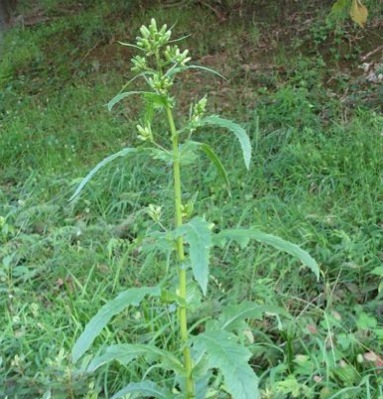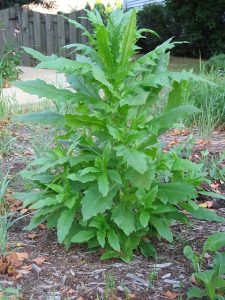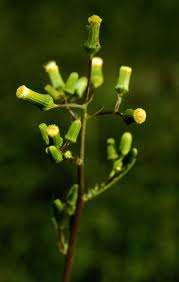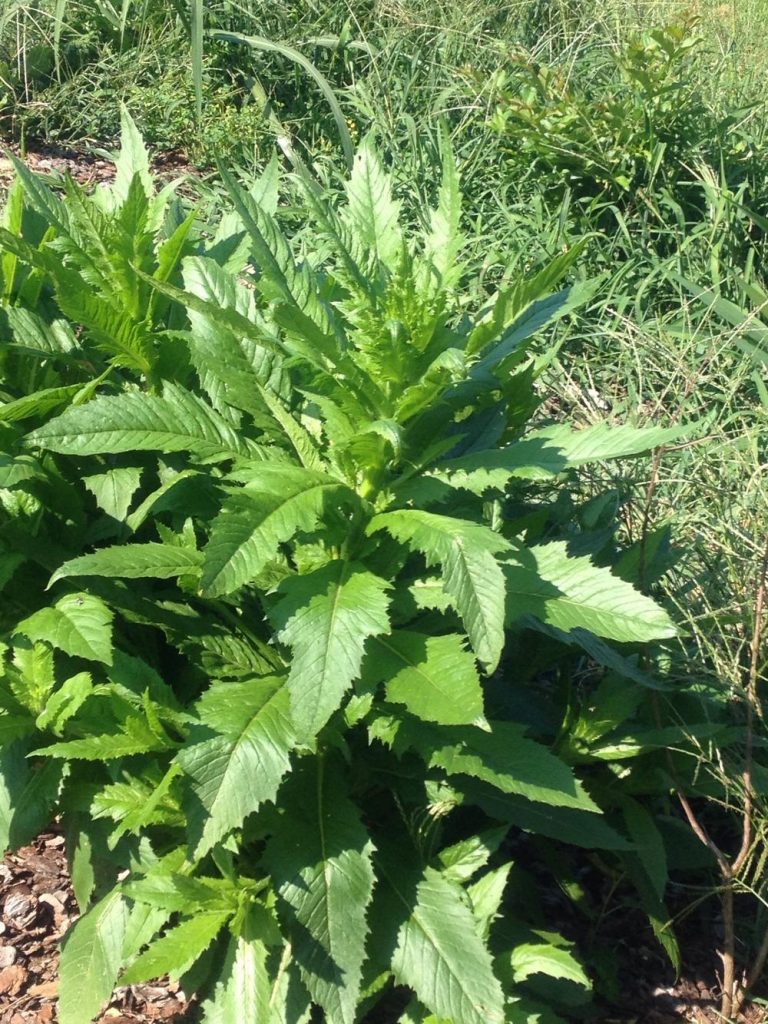
Erechtites hieraciifolia: Edible Pile Driver
When I go to Greece I always stay a few days in Athens to get used to the time change and visit in-town relatives (as opposed to out-of-town relatives.) I stay at the same little hotel — the Art Gallery Pension — on Erekthion Street. It’s a few hundred feet due south of the Acropolis and the Erechtheon, a shrine also atop the Acropolis (or Acropoli as the Greeks say.) I also stay at the same pension a month or so later when I am ready to leave, to enjoy the Plaka night life after I’ve adjusted to the time change and to visit in-town relatives again. So when I see Fireweed’s scientific name, Erechtites hieraciifolia, though half a world away I am reminded that even after some two and a half millennia the language of the past is still with us, particularly with Greek in botany. More on that later.
Opinions vary greatly on the Fireweed. Horrible, a choice edible, or toxic? Widely used in the past and the present in Asia this is not a dainty-flavored plant. While young leaves can be eaten raw and older ones cooked Native Americans did not use it for food but rather medicine. This might give us pause to be cautious. A 1939 study found the plant has pyrrolidines. That’s a group of chemicals that can damage your liver, permanently. Usually species with pyrrolidines are not eaten. Yet this plant has a history of consumption.
Merritt Lyndon Fernald, of Gray’s Manual of Botany and also co-author of Edible Wild Plants of Eastern North America, wrote twenty years after the above study: “There is no reason, except the odor, that prevents us from using it.” Dick Deuerling, author of Florida’s Incredible Wild Edibles, told me personally he only ate tasty wild foods and that did not include the E. hieracifolia, though he included it in his book. Dr. James A. Duke author of the Handbook of Edible Weeds and a second book, Medicinal Plants, said he could not improve on the comments of Troy Peterson, author of A Field Guide to Edible Wild Plants who said of the E. hieraciifolia: “The strong flavor suggests this is an acquired taste.” Duke recommends we don’t eat it.
That said I have a good friend who enjoys the flavor immensely, raw or cooked. Here’s what one reader — below –had to say about it: “I’m honestly perplexed with regards to the culinary reputation of this plant. Every chef I’ve shown this plant to so far has been really impressed, in a good way. The distinct perfume and flavor goes amazingly well in multiple preparations. I did cold blanched greens Korean style with sesame oil and soy sauce, brown rice steamed with chopped fireweed and shiso, and a quick chutney pickle of peeled fireweed stems and leaf tips, poor man’s pepper, nasturtium leaves, chopped apples, cucumber and coriander. I also used it as a soup base with lamb’s quarter and nettle. One vegetarian cold soup with raw goat buttermilk and the cooked wild greens puree, and one with chicken broth. The blanched greens also went into translucent summer roll wraps with sauteed pickerelweed, plantain seed heads, chanterelles, venison and nasturtium flowers, to be served with the chutney.
Not a single person in the large class (22 students + wildlife center interns and instructors) found the fireweed to be less than delicious prepared by these methods. All of the above dishes vanished like snow on a hot griddle, and I had to go harvest more fireweed after class so there would be any left for my chef buddy to play with at his restaurant. They ate it all.
Identification is 100% certain; this is Erechtites hieraciifolia. Properly prepared, it is delicious, and all of the local professional chefs whom I’ve gotten interested in wildcrafted foods are pretty excited to work with this plant. It’s not at its best raw and unadorned, but a little kitchen tweaking and flavor pairing and it’s suddenly amazing.
All I can say is if other foragers don’t know how to use and appreciate this green, that just leaves more for me and my chef friends!”
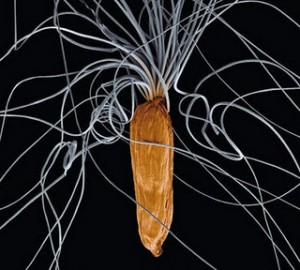 E. hieraciifolia has been viewed a famine food as the Caesar Weed (Urena lobata) is a famine food: Nutritious, common, and edible if you can get past this or that. With Caesar Weed it is texture, with E. hieraciifolia it is aroma and flavor though opinions do vary from ugh to delicious. These plants are plentiful in the spring and summer. Tall, rank and in your face, it is hard to misidentify a Fireweed. Foul or not it is as good as any other spring/summer green and is not unheard of in winter either. Perhaps the key is proper preparation. Fernald did not have a lot of chefs giving the green a try.
E. hieraciifolia has been viewed a famine food as the Caesar Weed (Urena lobata) is a famine food: Nutritious, common, and edible if you can get past this or that. With Caesar Weed it is texture, with E. hieraciifolia it is aroma and flavor though opinions do vary from ugh to delicious. These plants are plentiful in the spring and summer. Tall, rank and in your face, it is hard to misidentify a Fireweed. Foul or not it is as good as any other spring/summer green and is not unheard of in winter either. Perhaps the key is proper preparation. Fernald did not have a lot of chefs giving the green a try.
As to the scientific name, Erechtites hieraciifolia. The latter part, hieraciifolia, is easy: It means “having leaves like the hawkweed,” referring to the Hieracium (which itself means of or pertaining to priests.) But, Erechtites is more involved and botanists tend to not know their Greek. One, for example, will say the genus name may come from Erechtho, to break. Another says it might be for the fable early king of Athens, Erechtheus. Both close but no cigar. They need to read more of the Classics.
The goddess Athena went to the lame blacksmith-god Hephaestrus. He was the tool maker for the gods. She wanted some weapons. (For sake of the story we will set aside why a goddess would need weapons or someone to make them.) Things did not go as she planned. Hephaestrus found her so enticing that he tried to overpower her and take away her virginity. She successfully resisted and he missed his mark, so to speak, leaving a deposit on her thigh. With a scrap piece of wool she wiped it off and threw the wool to the ground. That impregnated the earth, Gaia. Gaia gave birth to a son and took him to Athena who named him Erichthonius. Erextho means trouble and xthon means earth. The name has come to mean “troubles from the earth” for a troublesome, ruderal weed that pops up after fires. The transliterated spelling varies greatly. Erechtites was also the name of an ancient groundsel in Greece and was first used to describe a plant in 40-80 CE by Dioscorides (for whom the yam genus is named.) King Erechtheus, who invented the chariot, was actually an early king of Attica not Athens but the region of Attica included Athens.
The plant has many local names as well besides Fireweed: Goat’s Chicory, Burn Weed, Stickers, Sun’s Ribs, Dog Weed and American Burnweed. There is also a second “Fireweed” a tall perennial (Epilobium angustifolium) in the evening-primrose family with spikes of pinkish-purple flowers. It is also edible. Our Fireweed has one other common name: Pilewort. Folks used Oil of Fireweed to externally treat their hemorrhoids. Fireweed puts out the fire. A poultice of the leaves work well I am told. Fireweed also has some internal uses as well such as treating dysentery.
And I saved this for last. The pronunciation of Erechtites hieraciifolia, is eleven syllables: e-rek-TEE-tez hee-eh-rak-ee-FO-li-a. I should mention that some folks remember Erechtites by starting with “Eric’s Teeties.” Clearly Greeks like long words. That is why it is easy to tell the difference between an Irish and Greek cemetery. When you drive by the Irish cemetery the stones are all tall and skinny with vertically engraved short names like Sean Ireland. Whereas all the stones in the Greek cemetery are low and long to accommodate Βασιλιος Σταβρος Τσαπατσαρις.
Green Deane’s Itemized Profile
IDENTIFICATION: Erect annual to 80 inches, flower yellow to whitish, 1/3″- 2/3″ inches long; inflorescence flat-topped to elongated clusters of drooping heads, flowers barely open; fruit, a dry seed on a bright white fluffy powder puff. Leaf alternate, lance-shaped, sharply toothed, some times lobed. It has a … ah… distinctive aroma that once you know is unmistakeable.
TIME OF YEAR: Blooms early summer to autumn.
ENVIRONMENT: Dry to wet; open woods, partially disturbed sites, fields, lake shores. Often colonial.
METHOD OF PREPARATION: Tops, leaves, flower buds raw or cooked, including steaming and boiling.
* E. hieracifolia (L.) Raf. PYRROLIZIDINE ALKALOID: hieracifoline. Manske, Can. J. Res., 17B, 8 (1939)



